Case Example: Reuse of Unconventional Materials in Staged Environments
Winslow theatre production
L’Escaouette Theatre and Company
Moncton, New Brunswick, Canada

Set designer Noémie Avidaher’s concern about the significant waste and toxicity generated by theatre sets and costume shops sparked her interest in ecoscenography. Avidaher focuses on stage designs and materials selection using local materials for a place-based connection, making creative use of ‘found’ objects and materials. The environmental benefits of sourcing locally include reducing shipping-related greenhouse gas emissions. Extending the life of ‘found’ materials contributes to circular practices.
Definition Ecoscenography
A design approach that applies ecological principles to create performance spaces and other staged environments that are recyclable, biodegradable, restorative and/or regenerative.
To be ‘ecological’ means being concerned with the wider effects of scenographic production, to consider how it affects and relates to the broader ecosystem (beyond the theatre). It entails incorporating principles of ecology to create recyclable, biodegradable, restorative and/or regenerative performance spaces. This is intrinsic to ecoscenographic practice. Source: Ecoscenography website
In a 2020 interview posted online on the Ecoscenography website, Avidaher stated: “…I am not just talking about using recycled materials or water-soluble paints. For me, it is more about how I engage with the space itself – how I can create a conversation with it and inhabit it without erasing its characteristics.”
For her work with L’Escaouette theatre company in Moncton, New Brunswick, Canada, Avidaher emphasized both circular solutions and place-based design.
While working on the set design of Winslow, Avidaher discovered that fishermen in this thriving region replace their cables and ropes every five years. She repurposed these discarded materials from the local area, collaborating with the production team to transform them into a striking large screen. A total of 1,462 ropes were painted white and assembled into a 50-by-20-foot rope wall. The wall was then painted with images of British military men, reflecting the play’s storyline.

After the production ended, the cable and rope wall was stored for reuse in future projects, including remounting the show, museum installations and pedagogical initiatives for schools.
Avidaher views ecoscenography as shaping performance spaces in harmony with their surroundings. In Moncton, a port city with strong ties to maritime history, the use of fishing ropes and cables for Winslow was a particularly fitting choice.
Avidaher is concerned that entrenched theatre conventions and fast production cycles hinder producers and managers from adopting more circular approaches, such as sourcing found objects or repurposing materials. Her advice: “Don’t constrain yourself with limitations and rules.”